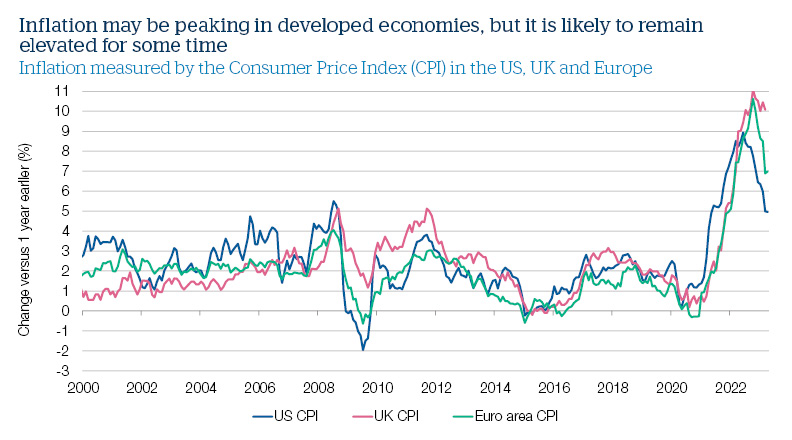Key takeaways
Taking a closer look at the landscape for financial markets, and what this means for our investment strategies
- High-profile banking sector failures could impact lending conditions in the wider economy, but do not indicate sector-wide stress
- There are signs that inflation has peaked in developed economies, but it remains elevated
- Central banks could keep rates at higher levels for some time, in order to assess the inflation picture
- We continue to see better relative value in bond markets versus stock markets
- We have further adjusted the mix of assets held in our investment strategies, creating more defensiveness
Should we worry about the banking sector?
Well-publicised recent issues in the banking sector have added an air of nervousness to some areas of financial markets. Since the start of the year, four banks have failed, three of which were based in the US. We know that events like this are unsettling, least not because they bring to mind the 2008 financial crisis. However, it’s important to note that this is not 2008, which played host to a catastrophic chain of events centred on credit (debt) markets. Today, the problems facing some banks have more to do with liquidity (the ease with which assets can be bought and sold), rather than credit.
In many ways, these current issues demonstrate the lagged effects of interest rate rises at central banks, which have exposed some vulnerable institutions unable to service their liabilities in these conditions. Unfortunately, some casualties were inevitable as the knock-on effects of a higher interest rate regime were slowly digested. Importantly, we do not believe that these banking failures indicate signs of deep-rooted distress in the banking sector.
Nevertheless, these events will have an impact on bank lending, with lending standards becoming more restrictive, particularly for riskier borrowers. Surveys of smaller businesses indicate that borrowing conditions are already very tight – perhaps their tightest in a decade – meaning that it is now more difficult/expensive for some smaller or riskier businesses to borrow from their banks. Again, this doesn’t mean we’re expecting a ‘credit crunch’ scenario, as in 2008, but it does mean that we are likely to see a gradual reduction in economic activity as businesses struggling to borrow begin to simply do less. This plays into the hands of central banks, who are actively trying to reduce economic activity in order to rein in inflation.
Have central banks finished raising interest rates?
As banks reduce the amount of credit available to businesses and consumers, inadvertently restricting economic activity, this is likely to do some of the work for central banks. In turn, this could lessen the need for policymakers to continue hiking interest rates quite so aggressively as in the recent past.
From our current vantage point, it’s difficult to predict where the precise end point will be for interest rate rises, but we continue to believe that central banks are closer to the end than the beginning of the current set of rate hikes. In the first half of 2023, we think that the US Federal Reserve Bank (Fed) will have stopped raising interest rates. Indeed, financial markets are predicting interest rate cuts from the Fed in the second half of this year, but we think this is probably premature: central banks have staked their credibility on taking the heat out of inflation, and – all else being equal – they won’t lower interest rates until they’re absolutely sure the job has been done. Once they’ve stopped hiking, we think the Fed will hold interest rates steady for some time in order to monitor the economic environment.
When will inflation start to fall?
Inflation appears to have already peaked, or at least be hovering around its peak, in most major economies. A number of factors have helped pricing pressures to ease, including the falling back of energy prices and the normalisation of previously embattled supply chains. Recent economic data has also been broadly softer, albeit a number of readings have continued to positively surprise analysts. Though it sounds perverse, weaker economic data is part of the goal for central banks across the developed world. To reiterate: reducing economic activity should help to bring down inflation.
Even so, despite some encouraging signs, inflation is likely to remain elevated for the foreseeable future. This is due to a range of influences, including stubbornly rising US wages and ongoing price rises in the service sector. We continue to watch economic, industry and market data very closely for signs of change.
Under the bonnet in our investment strategies
In recent months, we have been reducing the relative prevalence of riskier asset types like shares and alternative assets (i.e. assets outside of traditional bond and stock markets) within our investment strategies. This has reflected our belief that there are better opportunities elsewhere in financial markets, including in bond markets.
Below, we have highlighted some of the key convictions currently at work in our strategies.
